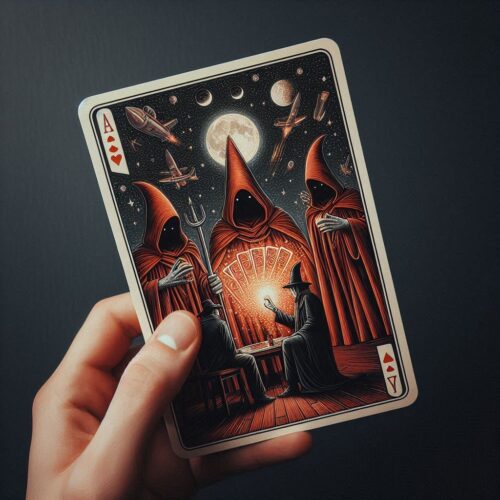I’ll Name That Card in One A Masterful Mind-Reading Card Trick. The “I’ll Name That Card in One” trick is a brilliant illusion that combines a well-arranged deck, a bit of math, and the power of suggestion. By creating the illusion of reading minds, this trick lets you amaze audiences and perform a seemingly impossible feat. Here’s a complete guide to mastering this card effect, from setting up the deck to revealing the chosen card with flair.
I’ll Name That Card in One A Masterful Mind-Reading Card Trick
Requirements for the Trick
- A Normal Deck of Cards: Although it’s a regular deck, the cards need to be organized in a specific order.
- Si Stebbins System: This is a classic method for stacking a deck, making it possible to know the exact order of each card, even after the deck has been cut.
How the Si Stebbins System Works
The Si Stebbins system relies on assigning values to each card:
- Face Cards: Jack (11), Queen (12), King (13).
- Aces and Number Cards: Ace is valued at 1, and number cards take their respective values.
The suits follow a specific order: Clubs, Hearts, Spades, Diamonds. You can remember this order by the word “CHASED.”
Stacking the Deck
- Choose a Starting Card: Begin with any card, such as the 3 of clubs (3C).
- Add 3 to Each Value: Following the CHASED sequence, add 3 to each card’s value as you move to the next suit.
- For example, if you start with 3 of clubs, the stack order becomes: 3C, 6H, 9S, QD, 2C, 5H, 8S, and so on.
- Arrange the Entire Deck: Stack the entire deck in this pattern, cycling through the CHASED order and adding 3 to each card’s value. Place the cards face up so you can keep track of the order.
Performing the Trick
Step 1: Setting Up the Scene
- Present the Deck: Fan the cards slightly to the audience without drawing attention to the order. Casually refer to it as a “normal deck of cards.”
- Invite a Spectator to Cut the Deck: Ask a spectator to cut the deck at any point and select the card at the top of the lower portion. Instruct them to keep the card hidden from you.
Step 2: Knowing the Chosen Card
- Reassemble the Deck: After the spectator removes their chosen card, place the deck back together with the spectator’s half on top.
- Glance at the Bottom Card: As you hold the deck, subtly glance at the bottom card. Use a simple distraction, like putting the cards back in the box or adjusting your grip, to sneak a peek.
Step 3: Identify the Chosen Card
- Using the Si Stebbins system, you can determine the spectator’s card by calculating the next card in the sequence.
- For instance, if the bottom card is the Ace of Hearts, the spectator’s card will be three cards higher in the sequence, following the CHASED suit order—making it the 4 of Spades in this example.
Revealing the Card with Dramatic Effect
- Build Suspense: Look into the spectator’s eyes as if analyzing their thoughts. You can heighten the drama by gradually “guessing” the characteristics of their card.
- Partial Revelation: Begin with small clues—state the color first, then whether it’s a low, high, or face card.
- Final Reveal: Name the exact card, or if you want to make it more theatrical, draw the card on a notepad. After the spectator reveals their card, show your drawing for a satisfying effect.
Adding Extra Flair: Suggestions for an Enhanced Performance
- Feign Uncertainty: As you guess the card, pretend to hesitate or “misinterpret” clues for added drama. For example, if the spectator’s card is the 9 of Clubs, you could say, “I’m seeing a black card… is it a five? No, wait… it’s a nine!”
- Alternative Reveal: Draw the card beforehand on a notepad, keeping it hidden until the spectator reveals their card. When they turn over their card, flip your notepad to show the same design, enhancing the illusion of mind-reading.
- Use Misdirection: Misdirection is key. When you glance at the bottom card, distract the audience with a casual gesture or question, making it seem unimportant.
Important Tips for a Convincing Performance
- Keep It Casual: Present the deck as a regular, shuffled deck without emphasizing its order. Fan the cards subtly, so the spectator assumes the deck is unarranged.
- Sell the Illusion: Act as though you’re genuinely reading subtle body language. This adds to the mystery and makes the trick appear more like authentic mind-reading.
- Respond to Every Outcome: If a spectator tries to “reconstruct” the trick, they’ll remember your casual demeanor and disregard the possibility of a stacked deck.
Handling Spectator Suspicion
If the spectator suspects the deck was arranged, your casual approach will make it hard for them to prove. Additionally, by shuffling in front of them in future performances, you can keep the audience confident that the trick is genuine and reduce any suspicions about the setup.
Conclusion: The Power of Illusion and Performance
“I’ll Name That Card in One” is not only a mental feat but also a masterful use of psychology and suggestion. By mastering the Si Stebbins system and adding a touch of drama, you can create a lasting impact on your audience. This trick exemplifies how simple mathematics and clever structuring can simulate mind-reading, allowing you to astonish your spectators time and time again.
With practice, you’ll gain confidence and find creative ways to deliver the reveal, ensuring every performance feels fresh and spontaneous. Through this trick, you’ll experience firsthand the power of illusion and the art of entertainment.




